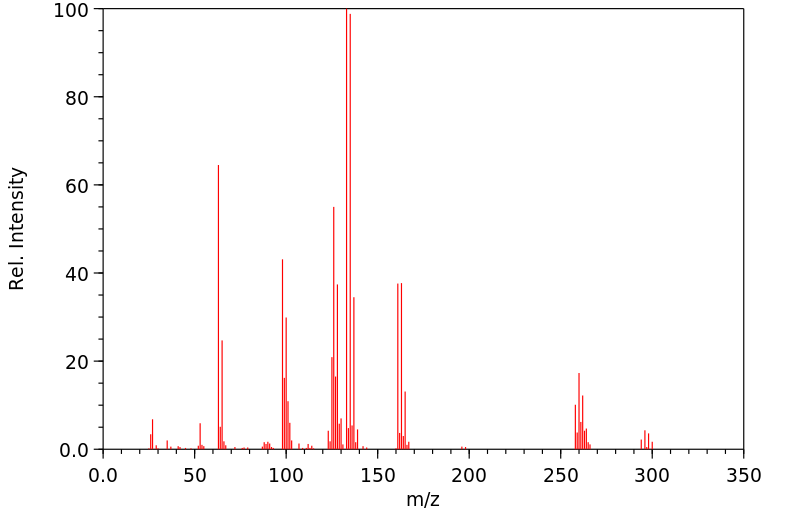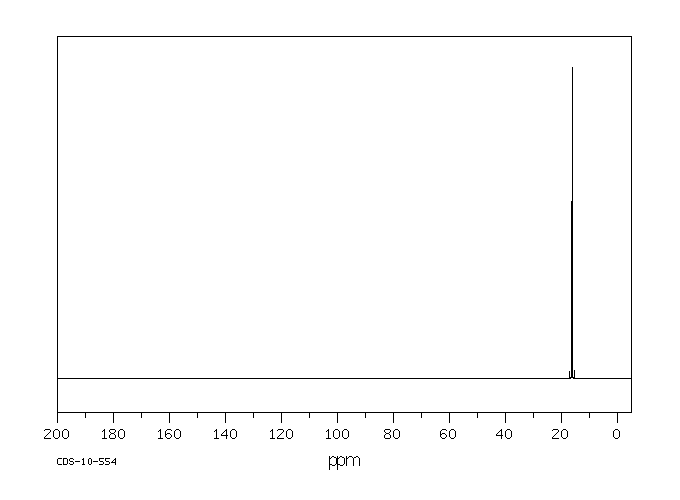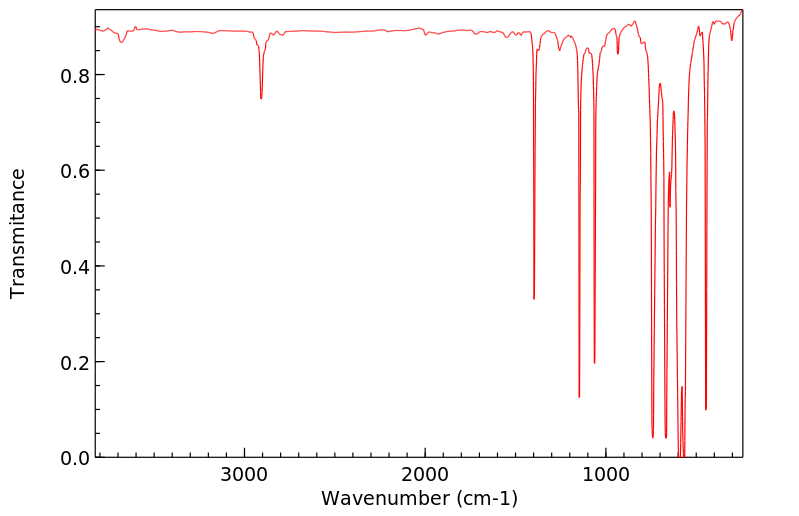1,2-二(三氯甲硅基)乙烷 | 2504-64-5
中文名称
1,2-二(三氯甲硅基)乙烷
中文别名
1,2-二(三氯甲硅烷基)乙烷;1,1,1,4,4,4-六氯二甲硅基乙烯;1,2-双(三氯硅烷)乙烷;1,2-双(三氯硅基)乙烷;1,2-双(三氯甲硅基)乙烷
英文名称
1,2-bis(trichlorosilyl)ethane
英文别名
trichloro(2-trichlorosilylethyl)silane
CAS
2504-64-5
化学式
C2H4Cl6Si2
mdl
MFCD00013601
分子量
296.943
InChiKey
WDVUXWDZTPZIIE-UHFFFAOYSA-N
BEILSTEIN
——
EINECS
——
-
物化性质
-
计算性质
-
ADMET
-
安全信息
-
SDS
-
制备方法与用途
-
上下游信息
-
文献信息
-
表征谱图
-
同类化合物
-
相关功能分类
-
相关结构分类
物化性质
-
熔点:27-29 °C(lit.)
-
沸点:202 °C(lit.)
-
密度:1.483 g/mL at 25 °C(lit.)
-
闪点:149 °F
计算性质
-
辛醇/水分配系数(LogP):3.68
-
重原子数:10
-
可旋转键数:1
-
环数:0.0
-
sp3杂化的碳原子比例:1.0
-
拓扑面积:0
-
氢给体数:0
-
氢受体数:0
安全信息
-
TSCA:Yes
-
危险等级:8
-
危险品标志:C
-
安全说明:S26,S36/37/39,S43,S45
-
危险类别码:R14
-
WGK Germany:3
-
海关编码:29319090
-
危险品运输编号:UN 3261 8/PG 1
-
危险标志:GHS05
-
危险性描述:H314
-
危险性防范说明:P280,P305 + P351 + P338,P310
-
储存条件:2-8°C
SDS
Section I.Chemical Product and Company Identification
Chemical Name 1,2-Bis(trichlorosilyl)ethane
Portland OR
Synonym Silane, 1,1'-(1,2-ethanediyl)bis[1,1,1-trichloro- (CA
INDEX NAME)
Chemical Formula C2H4Cl6Si2
2504-64-5
CAS Number
Section II. Composition and Information on Ingredients
Chemical Name CAS Number Percent (%) TLV/PEL Toxicology Data
1,2-Bis(trichlorosilyl)ethane 2504-64-5 Min. 95.0 (T) Not available. Not available.
Section III. Hazards Identification
Corrosive to skin, eyes, and respiratory system. Liquid or spray mist may produce tissue damage, particularly in mucous
Acute Health Effects
membranes of the eyes, mouth and respiratory tract. Skin contact may produce burns. Eye contact can result in corneal
damage or blindness. Inhalation of the spray mist may produce severe irritation of respiratory tract, characterized by
coughing, choking, or shortness of breath. Corrosive materials may cause serious injury if ingested.
Follow safe industrial hygiene practices and always wear proper protective equipment when handling this compound.
CARCINOGENIC EFFECTS : Not available.
Chronic Health Effects
MUTAGENIC EFFECTS : Not available.
TERATOGENIC EFFECTS : Not available.
DEVELOPMENTAL TOXICITY: Not available.
Repeated or prolonged contact with spray mist may produce chronic eye irritation and severe skin irritation. Repeated or
prolonged exposure to spray mist may produce respiratory tract irritation leading to frequent attacks of bronchial infection.
Section IV. First Aid Measures
Eye Contact Check for and remove any contact lenses. In case of contact, immediately flush eyes with plenty of water for at least 15
minutes. Get medical attention.
Skin Contact In case of contact, immediately flush skin with plenty of water. Remove contaminated clothing and shoes. Wash clothing
before reuse. Thoroughly clean shoes before reuse. Get medical attention.
Inhalation If the victim is not breathing, perform mouth-to-mouth resuscitation. Loosen tight clothing such as a collar, tie, belt or
waistband. If breathing is difficult, oxygen can be administered. Seek medical attention if respiration problems do not
improve.
Ingestion DO NOT INDUCE VOMITING. Loosen tight clothing such as a collar, tie, belt or waistband. If the victim is not breathing,
perform mouth-to-mouth resuscitation. Examine the lips and mouth to ascertain whether the tissues are damaged, a possible
indication that the toxic material was ingested; the absence of such signs, however, is not conclusive.
Section V. Fire and Explosion Data
200°C (392°F)
Auto-Ignition
Flammability May be combustible at high temperature.
Flammable Limits Not available.
Flash Points 78°C (172.4°F).
Combustion Products These products are toxic carbon oxides (CO, CO2), halogenated compounds. Silicates.
WARNING: Highly toxic HCl gas is produced during combustion.
Fire Hazards Not available.
Risks of explosion of the product in presence of mechanical impact: Not available.
Explosion Hazards
Risks of explosion of the product in presence of static discharge: Not available.
Fire Fighting Media SMALL FIRE: Use DRY chemical powder.
and Instructions LARGE FIRE: Use water spray, fog or foam. DO NOT use water jet.
Consult with local fire authorities before attempting large scale fire-fighting operations.
Continued on Next Page
1,2-Bis(trichlorosilyl)ethane
Section VI. Accidental Release Measures
Spill Cleanup Corrosive material. Moisture sensitive material.
Stop leak if without risk. If the product is in its solid form: Use a shovel to put the material into a convenient waste disposal
Instructions
container. If the product is in its liquid form: Absorb with DRY earth, sand or other non-combustible material. DO NOT get
water inside container. Absorb with an inert material and put the spilled material in an appropriate waste disposal. DO NOT
touch spilled material. Use water spray curtain to divert vapor drift. Prevent entry into sewers, basements or confined areas;
dike if needed. Eliminate all sources of ignition. Consult federal, state, and/or local authorities for assistance on disposal.
Section VII. Handling and Storage
CORROSIVE. MOISTURE SENSITIVE. HANDLE AND STORE UNDER ARGON. Keep container dry. Keep away from
Handling and Storage
heat. Mechanical exhaust required. When not in use, tightly seal the container and store in a dry, cool place. Avoid
Information
excessive heat and light. Do not breathe gas/fumes/ vapor/spray. Never add water to this product. Wear suitable protective
clothing. If you feel unwell, seek medical attention and show the label when possible. Treat symptomatically and
supportively.
Always store away from incompatible compounds such as oxidizing agents, moisture.
Section VIII. Exposure Controls/Personal Protection
Provide exhaust ventilation or other engineering controls to keep the airborne concentrations of vapors below their respective
Engineering Controls
threshold limit value. Ensure that eyewash station and safety shower is proximal to the work-station location.
Face shield. Lab coat. Dust respirator. Boots. Gloves. Suggested protective clothing might not be sufficient; consult a
Personal Protection
specialist BEFORE handling this product. Be sure to use a MSHA/NIOSH approved respirator or equivalent.
Not available.
Exposure Limits
Section IX. Physical and Chemical Properties
Physical state @ 20°C Liquid. (White, lumps.) Solubility
Not available.
1.483 (water=1)
Specific Gravity
Molecular Weight 296.94 Partition Coefficient Not available.
Boiling Point Not available. Vapor Pressure <0.13 kPa (@ 25°C)
28°C (82.4°F) (freezing point) Not available.
Melting Point Vapor Density
Refractive Index Not available. Volatility Not available.
Not available. Not available.
Critical Temperature Odor
Not available. Not available.
Viscosity Taste
Section X. Stability and Reactivity Data
This material is stable if stored under proper conditions. (See Section VII for instructions)
Stability
Conditions of Instability Avoid excessive heat and light. Moisture sensitive.
Incompatibilities
Reactive with strong oxidizing agents, moisture.
Section XI. Toxicological Information
Not available.
RTECS Number
Eye Contact. Ingestion. Inhalation. Skin contact.
Routes of Exposure
Not available.
Toxicity Data
Chronic Toxic Effects CARCINOGENIC EFFECTS : Not available.
MUTAGENIC EFFECTS : Not available.
TERATOGENIC EFFECTS : Not available.
DEVELOPMENTAL TOXICITY: Not available.
Repeated or prolonged contact with spray mist may produce chronic eye irritation and severe skin irritation. Repeated or
prolonged exposure to spray mist may produce respiratory tract irritation leading to frequent attacks of bronchial infection.
Acute Toxic Effects Corrosive to skin, eyes, and respiratory system. Liquid or spray mist may produce tissue damage, particularly in mucous
membranes of the eyes, mouth and respiratory tract. Skin contact may produce burns. Eye contact can result in corneal
damage or blindness. Inhalation of the spray mist may produce severe irritation of respiratory tract, characterized by
coughing, choking, or shortness of breath. Corrosive materials may cause serious injury if ingested.
Follow safe industrial hygiene practices and always wear proper protective equipment when handling this compound.
Continued on Next Page
1,2-Bis(trichlorosilyl)ethane
Section XII. Ecological Information
Ecotoxicity Not available.
Not available.
Environmental Fate
Section XIII. Disposal Considerations
Recycle to process, if possible. Consult your local regional authorities. You may be able to dissolve or mix material with a
Waste Disposal
combustible solvent and burn in a chemical incinerator equipped with an afterburner and scrubber system. Observe all
federal, state and local regulations when disposing of the substance.
Section XIV. Transport Information
DOT Classification DOT Class 8: Corrosive material
PIN Number
Proper Shipping Name Chlorosilanes, corrosive, n.o.s.
II
Packing Group (PG)
DOT Pictograms
Section XV. Other Regulatory Information and Pictograms
TSCA Chemical Inventory This compound is ON the EPA Toxic Substances Control Act (TSCA) inventory list.
(EPA)
WHMIS Classification CLASS E: Corrosive liquid.
On NDSL
(Canada)
EINECS Number (EEC) 219-710-9
EEC Risk Statements R34- Causes burns.
SECTION 16 - ADDITIONAL INFORMATION
N/A
反应信息
-
作为反应物:描述:1,2-二(三氯甲硅基)乙烷 在 lithium aluminium tetrahydride 作用下, 以 二丁醚 为溶剂, 反应 2.0h, 以65%的产率得到1,4-disilabutane参考文献:名称:[EN] CATALYST DEHYDROGENATIVE COUPLING OF CARBOSILANES WITH AMMONIA, AMNINES AND AMIDINES
[FR] COUPLAGE DÉSHYDROGÉNATIF CATALYTIQUE DE CARBOSILANES AVEC DE L'AMMONIAC, DES AMINES ET DES AMIDINES摘要:本发明揭示了包含Si-N前体物的Si含量薄膜形成组合物。还揭示了合成这些组合物的方法以及将其用于蒸汽沉积的方法。特别地,通过使用氨、胺和酰胺与碳硅烷的催化脱氢偶联反应可以产生Si-N前体物。公开号:WO2016160991A1 -
作为产物:描述:三氯硅烷 在 C6H6 作用下, 以 neat (no solvent) 为溶剂, 生成 1,2-二(三氯甲硅基)乙烷参考文献:名称:Gmelin Handbuch der Anorganischen Chemie, Gmelin Handbook: Si: MVol.C, 63, page 177 - 179摘要:DOI:
文献信息
-
PROCESS FOR PREPARING ORGANOCHLOROSILANES BY DEHYDROHALOGENATIVE COUPLING REACTION OF ALKYL HALIDES WITH CHLOROSILANES申请人:——公开号:US20020082438A1公开(公告)日:2002-06-27The present invention relates to a process for preparing organochlorosilanes and more particularly, to the process for preparing organochlorosilanes of formula I by a dehydrohalogenative coupling of hydrochlorosilanes of formula II with organic halides of formula III in the presence of quaternary phosphonium salt as a catalyst to provide better economical matter and yield compared with conventional methods, because only catalytic amount of phosphonium chloride is required and the catalyst can be separated from the reaction mixture and recycled easily, 1 wherein R 1 represents hydrogen, chloro, or methyl; X represents chloro or bromo; R 2 is selected from the group consisting of C 1-17 alkyl, C 1-10 fluorinated alkyl with partial or full fluorination, C 2-5 alkenyl, silyl containing alkyl group represented by (CH 2 ) n SiMe 3-m Cl m wherein n is an integer of 0 to 2 and m is an integer of 0 to 3, aromatic group represented by Ar(R′) q wherein Ar is C 6-14 aromatic hydrocarbon, R′ is C 1-4 alkyl, halogen, alkoxy, or vinyl, and q is an integer of 0 to 5, haloalkyl group represented by (CH 2 ) p X wherein p is an integer of 1 to 9 and X is chloro or bromo, and aromatic hydrocarbon represented by ArCH 2 X wherein Ar is C 6-14 aromatic hydrocarbons and X is a chloro or bromo; R 3 is hydrogen, C 1-6 alkyl, aromatic group represented by Ar(R′) q wherein Ar is C 6-14 aromatic hydrocarbon, R′ is C 1-4 alkyl, halogen, alkoxy, or vinyl, and q is an integer of 0 to 5; and R 4 in formula I is the same as R 2 in formula III and further, R 4 can also be (CH 2 ) p SiR 1 Cl 2 or ArCH 2 SiR 1 Cl 2 , when R 2 in formula III is (CH 2 ) p X or ArCH 2 X, which is formed from the coupling reaction of X—(CH 2 ) p+1 —X or XCH 2 ArCH 2 X with the compounds of formula II; or when R 2 and R 3 are covalently bonded to each other to form a cyclic compounds of cyclopentyl or cyclohexyl group, R 3 and R 4 are also covalently bonded to each other in the same fashion.本发明涉及一种制备有机氯硅烷的方法,更具体地说,涉及一种通过在四元磷盐存在下,将式II的氯硅烷与式III的有机卤化物脱卤偶联以制备式I的有机氯硅烷的方法,与传统方法相比,该方法提供了更好的经济性和产量,因为只需要催化量的磷盐氯化物,并且催化剂可以从反应混合物中分离并轻松回收, 其中 R 1 代表氢、氯或甲基; X代表氯或溴; R 2 选自由C 1-17 烷基、C 1-10 部分或全氟化的氟烷基、C 2-5 烯基、含有(CH 2 ) n SiMe 3-m Cl m 的硅基烷基,其中n为0至2的整数,m为0至3的整数,由Ar(R′) q 表示的芳香族,其中Ar为C 6-14 芳香烃,R′为C 1-4 烷基、卤素、烷氧基或乙烯基,q为0至5的整数,由(CH 2 ) p X表示的卤代烷基,其中p为1至9的整数,X为氯或溴,以及由ArCH 2 X表示的芳香烃,其中Ar为C 6-14 芳香烃,X为氯或溴; R 3 为氢、C 1-6 烷基、由Ar(R′) q 表示的芳香族,其中Ar为C 6-14 芳香烃,R′为C 1-4 烷基、卤素、烷氧基或乙烯基,q为0至5的整数;以及 式I中的R 4 与式III中的R 2 相同,此外,当式III中的R 2 为(CH 2 ) p X或ArCH 2 X时,R 4 还可以是(CH 2 ) p SiR 1 Cl 2 或ArCH 2 SiR 1 Cl 2 ,其中R 2 在式III中为(CH 2 ) p X或ArCH 2 X,它由X—(CH 2 ) p+1 —X或XCH 2 ArCH 2 X与式II的化合物的偶联反应形成;或 当R 2 和R 3 以共价键结合形成环戊基或环己基化合物时,R 3 和R 4 也以相同方式共价键结合。
-
Process for preparing organochlorosilanes by dehydrohalogenative coupling reaction of alkyl halides with chlorosilanes申请人:Korea Institute of Science and Technology公开号:US06392077B1公开(公告)日:2002-05-21The present invention relates to a process for preparing organochlorosilanes and more particularly, to the process for preparing organochlorosilanes of R4R3CHSiR1Cl2 (I) by a dehydrohalogenative coupling of hydrochlorosilanes of HSiR1Cl2 (II) with organic halides of R2R3 CHX (III) in the presence of quaternary phosphonium salt as a catalyst to provide better economical matter and yield compared with conventional methods, because only a catalytic amount of phosphonium chloride is required and the catalyst can be separated from the reaction mixture and recycled easily.
-
폴리실릴알칸의 제조방법申请人:JSI Silicone Co. 제이에스아이실리콘주식회사(120060205772) Corp. No ▼ 135511-0143475BRN ▼134-86-07407公开号:KR20200015644A公开(公告)日:2020-02-12본 발명에 따른 폴리실릴 알칸은 아래의 식으로 표시되고 상기에서 m=n=0이고, R는 클로로, 메틸기이고; R는 H, -SiMeCl, -SiMe,-SiMeCl, -SiCl인 경우, R=-SiCl이고; R는 H이고, R= R = Me 또는 R=Me, R 는=Et인 경우, R -SiCl 이고; R는 H이고, R = -CHSiCl이고, R은 Me인 경우, R = -SiCl 가 되고; R는 H이고, R= R = -CHSiCl인 경우, R = Et, SiMeCl, -SiMeCl, -SiCl이고 그리고 m= 0~9인 정수가 된다.
-
Dehydrohalogenative coupling reaction of organic halides with silanes申请人:Korea Institute of Science and Technology公开号:US06251057B1公开(公告)日:2001-06-26The present invention relates to methods for making the compounds of formula I which is a dehydrohalogenative coupling of hydrochlorosilanes of formula II with organic halides of formula III in the presence of a Lewis base catalyst. R3CH2SiR1Cl2 (I) HSiR1Cl2 (II) R2CH2X (III) In formulas I and II, R1 represents a hydrogen, chloro, or methyl; in formula III, X represents a chloro or bromo; in formula III, R2 can be selected from the group consisting of a C1-17 alkyl, a C1-10 fluorinated alkyl with partial or full fluorination, a C1-5 alkenyl groups, a silyl group containing alkyls, (CH2)nSiMe3-mClm wherein n is 0 to 2 and m is 0 to 3, aromatic groups, Ar(R′)1 wherein Ar is C6-14 aromatic hydrocarbon, R′ is a C1-4 alkyl, halogen, alkoxy, or vinyl, and q is 0 to 5, a haloalkyl group, (CH2)pX wherein p is 1 to 9 and X is a chloro or bromo; or an aromatic hydrocarbon, Ar CH2X wherein Ar is C6-14 aromatic hydrocarbon and X is a chloro or bromo. in formula I, R3 is the same as R2 in formula III and further, R3 can also be (CH2)pSiR1Cl2 or ArCH2SiR1Cl2 when R2 in formula III is (CH2)pX or ArCH2X, because of the coupling reaction of X with the compound of formula II.本发明涉及一种制备式I化合物的方法,该方法是在Lewis碱催化剂存在下,通过式II的氢氯硅烷与式III的有机卤化物的脱氢卤代偶联而得到的。 R3 SiR1Cl2 (I) HSiR1Cl2 (II) R2 X (III) 在式I和II中,R1代表氢、氯或甲基;在式III中,X代表氯或溴;在式III中,R2可以选择自C1-17烷基、C1-10氟化烷基(部分或完全氟化)、C1-5烯基、含有矽烷基的矽基团(CH2)nSiMe3-mClm,其中n为0至2,m为0至3,芳香族基团、Ar(R′)1,其中Ar为C6-14芳香烃烃基,R′为C1-4烷基、卤素、烷氧基或乙烯基,q为0至5,卤代烷基、( )pX,其中p为1至9,X为氯或溴;或芳香烃基、Ar X,其中Ar为C6-14芳香烃烃基,X为氯或溴。在式I中,R3与式III中的R2相同,此外,R3也可以是( )pSiR1Cl2或Ar SiR1Cl2,当式III中的R2为( )pX或Ar X时,因为X与式II化合物的偶联反应。
-
Synthesis of a Counteranion‐Stabilized Bis(silylium) Ion作者:Qian Wu、Avijit Roy、Guoqiang Wang、Elisabeth Irran、Hendrik F. T. Klare、Martin OestreichDOI:10.1002/anie.202003799日期:2020.6.22The preparation of a molecule with two alkyl‐tethered silylium‐ion sites from the corresponding bis(hydrosilanes) by two‐fold hydride abstraction is reported. The length of the conformationally flexible alkyl bridge is crucial as otherwise the hydride abstraction stops at the stage of a cyclic bissilylated hydronium ion. With an ethylene tether, the open form of the hydronium‐ion intermediate is energetically
表征谱图
-
氢谱1HNMR
-
质谱MS
-
碳谱13CNMR
-
红外IR
-
拉曼Raman
-
峰位数据
-
峰位匹配
-
表征信息
同类化合物
(2-溴乙氧基)-特丁基二甲基硅烷
鲸蜡基聚二甲基硅氧烷
骨化醇杂质DCP
马沙骨化醇中间体
马来酸双(三甲硅烷)酯
顺式-二氯二(二甲基硒醚)铂(II)
顺-N-(1-(2-乙氧基乙基)-3-甲基-4-哌啶基)-N-苯基苯酰胺
降钙素杂质13
降冰片烯基乙基三甲氧基硅烷
降冰片烯基乙基-POSS
间-氨基苯基三甲氧基硅烷
镓,二(1,1-二甲基乙基)甲基-
镁,氯[[二甲基(1-甲基乙氧基)甲硅烷基]甲基]-
锑,二溴三丁基-
铷,[三(三甲基甲硅烷基)甲基]-
铂(0)-1,3-二乙烯-1,1,3,3-四甲基二硅氧烷
钾(4-{[二甲基(2-甲基-2-丙基)硅烷基]氧基}-1-丁炔-1-基)(三氟)硼酸酯(1-)
金刚烷基乙基三氯硅烷
酰氧基丙基双封头
达格列净杂质
辛醛,8-[[(1,1-二甲基乙基)二甲基甲硅烷基]氧代]-
辛甲基-1,4-二氧杂-2,3,5,6-四硅杂环己烷
辛基铵甲烷砷酸盐
辛基衍生化硅胶(C8)ZORBAX?LP100/40C8
辛基硅三醇
辛基甲基二乙氧基硅烷
辛基三甲氧基硅烷
辛基三氯硅烷
辛基(三苯基)硅烷
辛乙基三硅氧烷
路易氏剂-3
路易氏剂-2
路易士剂
试剂Cyanomethyl[3-(trimethoxysilyl)propyl]trithiocarbonate
试剂3-[Tris(trimethylsiloxy)silyl]propylvinylcarbamate
试剂3-(Trimethoxysilyl)propylvinylcarbamate
试剂2-(Trimethylsilyl)cyclopent-2-en-1-one
试剂11-Azidoundecyltriethoxysilane
西甲硅油杂质14
衣康酸二(三甲基硅基)酯
苯胺,4-[2-(三乙氧基甲硅烷基)乙基]-
苯磺酸,羟基-,盐,单钠聚合甲醛,1,3,5-三嗪-2,4,6-三胺和脲
苯甲醇,a-[(三苯代甲硅烷基)甲基]-
苯并磷杂硅杂英,5,10-二氢-10,10-二甲基-5-苯基-
苯基二甲基氯硅烷
苯基二甲基乙氧基硅
苯基二甲基(2'-甲氧基乙氧基)硅烷
苯基乙酰氧基三甲基硅烷
苯基三辛基硅烷
苯基三甲氧基硅烷










